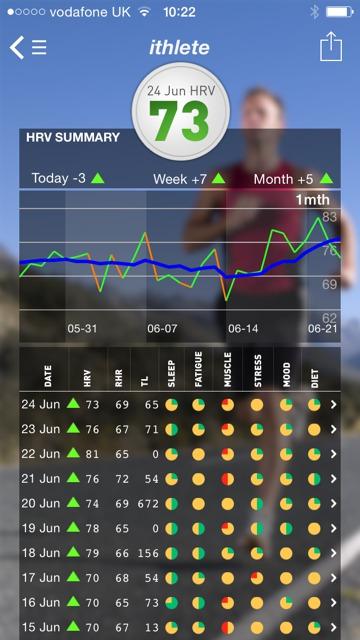How well can HRV and resting HR predict diabetes, heart disease and early death?
Who, what, why?
Medical researchers at the Cincinnati and Boston Medical Universities have recently analysed data that was collected over a 12 year period during the Framingham Heart Study. As far back as the 1950s, this visionary study was intended to look for risk factors that contribute to the chronic & costly cardiovascular health conditions that are the leading cause of early death in the Western world.
Many papers have been written using the Framingham data, and this one focuses on heart rate variability (HRV) and resting heart rate as predictors of cardiovascular disease, type-2 diabetes, and the so-called metabolic syndrome that also includes obesity and blood fat levels.
What did they do?
They recorded specific measurements from 1882 participants aged 21-76 at baseline:
- Age (48 ± 10 ys)
- Gender (52% female)
- Smoking habits
- Resting heart rate (65 ± 10 bpm)
- Heart rate variability (time domain measure SDNN 95 ± 28 ms)
The outcome measures they looked at during the 12 year follow up period were:
- Body mass index (BMI)
- High blood pressure
- High blood glucose
- Low HDL cholesterol
- High triglycerides
- Cardiovascular disease (heart attack, stroke, heart failure)
- Type-2 diabetes
- Death (19% died within 12 years)
What did they find?
They found that both reduced HRV and increased resting HR were very reliable predictors of future high blood pressure and cardiovascular disease. In contrast, they found that neither HRV nor HR predicted high BMI, triglycerides, or low HDL cholesterol.
The most striking results though, came from the Hazard Ratios. This technique normalizes the average chance of developing a disease at 1.0 and then looks at what difference a significant increase (often 1 standard deviation) in the baseline characteristics has. For example, a hazard ratio of 0.8 means someone would be 0.2 (i.e. 20%) less likely than average to develop the condition. Conversely, for Hazard Ratios higher than 1.0, someone would be more likely than average to develop the disease. Hazard Ratios from the paper are as follows:
- Type-2 diabetes for HRV 0.55, for RHR 1.6
- Cardiovascular disease for HRV 0.82, for RHR 1.26
- Early death for HRV 0.68 for HR 1.23
What does it mean?
It would be difficult to overstate the importance of this study, which is (surprisingly) the first to analyse the Framingham study data in this way.
To brin g the hazard ratios into some perspective for ithlete users, although SDNN is not the same as RMSSD, they are both time domain HRV measures and dominated by parasympathetic changes. Roughly speaking therefore, a 5 point increase in an ithlete HRV baseline would reduce someone’s chances of contracting type-2 diabetes over the next 10 years by 40%, and their chances of an early death by 30%. Conversely, a 10 bpm increase in resting heart rate increases a person’s chance of getting cardiovascular disease by 25%. We sometimes think about these conditions as age related diseases, but the truth is that their build up is often slow, and future patients are unaware of any symptoms until the onset of the disease.
g the hazard ratios into some perspective for ithlete users, although SDNN is not the same as RMSSD, they are both time domain HRV measures and dominated by parasympathetic changes. Roughly speaking therefore, a 5 point increase in an ithlete HRV baseline would reduce someone’s chances of contracting type-2 diabetes over the next 10 years by 40%, and their chances of an early death by 30%. Conversely, a 10 bpm increase in resting heart rate increases a person’s chance of getting cardiovascular disease by 25%. We sometimes think about these conditions as age related diseases, but the truth is that their build up is often slow, and future patients are unaware of any symptoms until the onset of the disease.
Existing recommendations for the treatment of high blood pressure or type-2 diabetes advise lifestyle changes including physical activity, however, the necessary lifestyle changes could be started much earlier, potentially preventing even the early stages of pre-diabetes and pre-hypertension.
Knowing what we do about the impact of regular exercise, sleep, diet and stress on parasympathetic HRV, and just how easy it is to monitor now it makes complete sense for everyone to check their HRV regularly and get to understand what affects it both positively and negatively for them as individuals.
And that’s why I started this company!
By Simon Wegerif
Original paper can be found here:

After using Ithlete for nearly three years it provides excellent statistics to look back and analyse the different benefits of various regimes such as exercise, stress relief, diet etc. I personally noted that for one six week period there was a hugely improved gap between my average resting heart rate and my average heart rate variance. Upon looking back it was clear that this was produced by Tabata 3 times per week! By monitoring the gap I can keep an eye on how my training is either improving my overall cardiovascular health or if I need to make changes.
Thanks Nigel, hope you are in robust health nowadays. Simon.